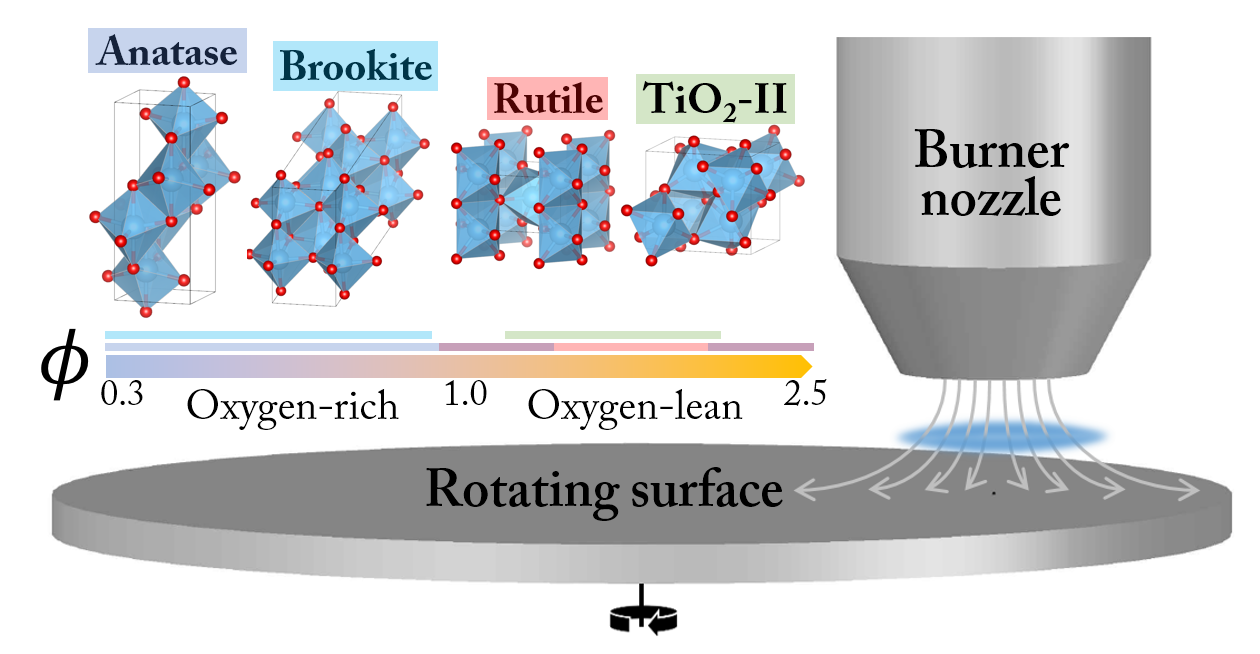Technical Report 200, c4e-Preprint Series, Cambridge
Polymorphism of nanocrystalline TiO2 prepared in a stagnation flame: Formation of TiO2-II phase
Reference: Technical Report 200, c4e-Preprint Series, Cambridge, 2018
- Anatase, brookite, rutile, and TiO2-II were synthesised with a stagnation flame by tuning the oxygen/fuel ratio.
- An anatase/TiO2-II/rutile three-phase heterojunction is formed in slightly oxygen-lean flames (Φ=1.1-1.3), and is potentially of interest for photocatalytic applications.
- The formation of the metastable TiO2-II phase cannot be explained thermodynamically. This suggests a kinetically driven transformation, possibly with a sub-oxide intermediate.
 A metastable "high-pressure" phase known as the α-PbO2-type TiO2 or TiO2-II is prepared in a single-step synthesis using a laminar premixed stagnation flame. Three other TiO2 polymorphs, namely anatase, rutile and brookite phases, can also be obtained by tuning the oxygen/fuel ratio. The TiO2-II is observed as a mixture with rutile in oxygen-lean flame conditions. To the best of our knowledge, this is the first time this phase has been identified in flame-synthesised TiO2. The formation of TiO2-II in an atmospheric pressure flame cannot be explained thermodynamically and is hypothesised to be kinetically driven through the oxidation and solid-state transformation of a sub-oxide TiO2-x intermediate. In this scenario, rutile is nucleated from the metastable TiO2-II phase instead of directly from a molten/amorphous state. Mixtures containing three-phase heterojunction of anatase, rutile, and TiO2-II nanoparticles as prepared here in slightly oxygen-lean flames might be important in photocatalysis due to enhanced electron-hole separation.
A metastable "high-pressure" phase known as the α-PbO2-type TiO2 or TiO2-II is prepared in a single-step synthesis using a laminar premixed stagnation flame. Three other TiO2 polymorphs, namely anatase, rutile and brookite phases, can also be obtained by tuning the oxygen/fuel ratio. The TiO2-II is observed as a mixture with rutile in oxygen-lean flame conditions. To the best of our knowledge, this is the first time this phase has been identified in flame-synthesised TiO2. The formation of TiO2-II in an atmospheric pressure flame cannot be explained thermodynamically and is hypothesised to be kinetically driven through the oxidation and solid-state transformation of a sub-oxide TiO2-x intermediate. In this scenario, rutile is nucleated from the metastable TiO2-II phase instead of directly from a molten/amorphous state. Mixtures containing three-phase heterojunction of anatase, rutile, and TiO2-II nanoparticles as prepared here in slightly oxygen-lean flames might be important in photocatalysis due to enhanced electron-hole separation.
Material from this preprint has been published in Chemical Science.
PDF (14.8 MB)



